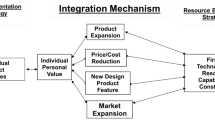Abstract
Mass customization efforts are challenged by an unpredictable growth or shrink in the market segments and shortened product life cycles which result in an opportunity loss and reduced profitability; hence we propose a concept of sustainable mass customization to address these challenges where an economically infeasible product for a market segment is replaced by an alternative superior product variant nearly at the cost of mass production. This concept provides sufficient time to restructure the product family architecture for the inclusion of a new innovative product variant while fulfilling the market segments with the customer delight and an extended profitability. To implement the concept of sustainable mass customization we have proposed the notions of generic-bill-Of-products (GBOP: list of product variants agreed for the market segments), its interface with generic-supply-chain-structure and strategic decisions about opening or closing of a market segment as an optimization MILP (mixed integer linear program) model including logistics and GBOP constraints. Model is tested with the varying market segments demands, sales prices and production costs against 1 to 40 market segments. Simulation results provide us an optimum GBOP, its respective segments and decisions on the opening or closing of the market segments to sustain mass customization efforts.
Similar content being viewed by others
References
Alberto Jose A., Tollenaere M. (2005) Modular and platform methods for product family design: Literature analysis. Journal of Intelligent Manufacturing 16(3): 371–390
Aldanondo M., Hadj-Hamou K., Moynard G., Lamothe J. (2003) Mass customization and configuration: Requirement analysis and constraint based modelling propositions. Integrated Computer-Aided Engineering 10(2): 177–189
Arntzen B. C., Brown G. G., Harrison T. P., Trafton L. L. (1995) Global supply chain management at digital equipment corporation. Interfaces 25(1): 69–93
Blackhurst J., Wu T., Grady P. O. (2005) PCDM: A decision support modelling methodology for supply chain, product and process design decisions. Journal of Operations Management 23: 325–343
Cohen M. A., Lee H. L. (1988) Strategic analysis of integrated production-distribution systems: Models and methods. Operations Research 36(2): 216–228
El Hadj Khalaf R., Agard B., Penz B. (2010) An experimental study for the selection of modules and facilities in a mass customization context. Journal of Intelligent Manufacturing 21(6): 703–716
Fixson S. K. (2005) Product architecture assessment: A tool to link product, process, and supply chain design decisions. Journal of Operations Management 23: 345–369
Ganeshan, R., Jack, E., Magazine, M. J., & Stephens, P. (1999). A taxonomic review of supply chain management research. In S. Tayur, R. Ganeshan, M. J. Magazine (Eds.), Quantitative models for supply chain management (pp. 839–876). Boston: Kluwer Academic Press.
Geoffrion A. M., Graves G. W. (1974) Multicommodity distribution system design by Benders decomposition. Management Science 20(5): 822–844
Geoffrion A. M., Powers R. F. (1995) Twenty years of strategic distribution system design: An evolutionary perspective. Implementation in OR/MS: An evolutionary view. Interfaces 23(3): 107–117
Goetschalckx M. (2000) Strategic network planning. In: Stadler H., Kilger C. (eds) Supply chain management and advanced planning. Springer, Heidelberg
Goetschalckx M., Vidal C. J., Doganc K. (2002) Modelling and design of global logistics systems: A review of integrated strategic and tactical models and design algorithms. European Journal of Operational Research 143(1): 1–18
Graves, S. C., & Willems, S. P. (2001). Optimizing the supply chain configuration for new products. Working paper, Sloan School of Management MIT.
Hegge H. M. H., Wortmann J. C. (1991) Generic bill-of-material: A new product model. International Journal of Production Economics 23(1–3): 117–128
Huang G. Q., Zhang X. Y., Liang L. (2005) Towards integrated optimal configuration of platform products, manufacturing processes, and supply chains. Journal of Operations Management 23: 267–290
Jiao J., Tseng M. M. (1999) A methodology of developing product family architecture for mass customization. Journal of Intelligent Manufacturing 10(1): 3–20
Jiao J., Tseng M. M., Ma Q., Zou Y. (2000) Generic BOM and operations for high-variety production management. Concurrent Engineering: Research and Application 8(4): 297–322
Lamothe J., Hadj-Hamou K., Aldanondo M. (2006) An optimization model for selecting a product family and designing its supply chain. European Journal of Operational Research 169(3): 1030–1047
Lucas C. A., Mitra G., Mirhassani S. (1999) Supply chain planning under uncertainty. In: Hadjiconsrantinou E. (eds) Quick response in the supply chain. Springer, Berlin
Meyer M., Lehnerd A. P. (1997) The power of product platforms: Building value and cost leadership. Free Press, New York
Rungtusanathama M., Forza C. (2005) Coordinating product design, process design, and supply chain design decisions part A: Topic motivation, performance implications, and article review process. Journal of Operations Management 23: 257–265
Santoso T., Ahmed S., Goetschalckx M., Shapiro A. (2005) A stochastic programming approach for supply chain network design under uncertainty. European Journal of Operational Research 167(1): 96–115
Sua J. C. P., Chang Y. L., Ferguson M. (2005) Evaluation of postponement structures to accommodate mass customization. Journal of Operations Management 23: 305–318
Thomas D. J., Griffin P. M. (1996) Coordinated supply chain management. European Journal of Operations Research 94(1): 1–15
Truong T. H., Azadivar F. (2005) Optimal design methodologies for configuration of supply chains. International Journal of Production Research 43(11): 2217–2236
Tseng M. M., Jiao J. (1996) Design for mass customization. CIRP Annals-Manufacturing Technology 45(1): 153–156
Ulrich K. (1995) The role of product architecture in the manufacturing firm. Research Policy 24: 419–440
Zhuo L., Yoke San W., Seng L. K. (2006) Integrated approach to modularize the conceptual product family architecture. International Journal of Advanced Manufacturing Technology 36: 83–96
Author information
Authors and Affiliations
Corresponding author
Rights and permissions
About this article
Cite this article
Shahzad, K.M., Hadj-Hamou, K. Integrated supply chain and product family architecture under highly customized demand. J Intell Manuf 24, 1005–1018 (2013). https://doi.org/10.1007/s10845-012-0630-0
Received:
Accepted:
Published:
Issue Date:
DOI: https://doi.org/10.1007/s10845-012-0630-0




